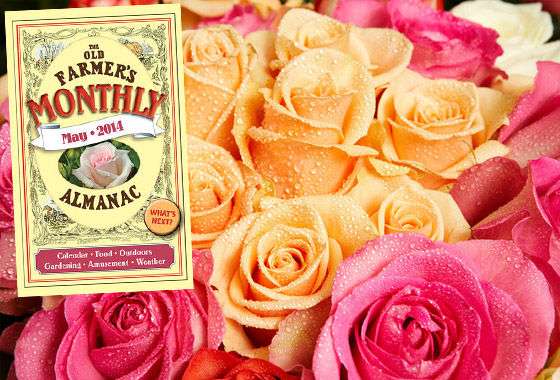Divide late-summer or autumn-flowering perennials. If necessary, go after phlox and artemisia with a sharp spade or even an ax. If delphiniums need to be divided, remove and replant the new little plants growing around the outside of the clump. Discard the hard old heart.
Trim climbing roses and attach securely to fences or trellises.
Scatter crushed eggshells in a thick ring around roses to deter slugs.
Melons often benefit from supplemental warming, such as that provided by growing under plastic. Wait until the transplanted seedlings are established, as they cannot take up moisture very well at first and can easily get dehydrated.
Mulch between rows and keep the garden weeded to give emerging seedlings a fair chance.
Get that herb garden started by putting in plants. If you include mint, plant it in a large plastic tub (the kind drywall joint compound or birdseed comes in) with its bottom removed. This will help keep it from invading the rest of the garden.
An established asparagus bed will be ready to harvest. Patrol daily and select spears of about the same size (which will require the same cooking time). If you had trouble locating those first spears, mark the bed with stakes so that you can find them next year.
Watch for signs of drought in plants transplanted from containers. Apply water (not much, but often) close to each plant's stem, where it will percolate down to the root ball. The larger the plant, the longer the recovery period, and the more diligently you need to water. Poke a pointed metal rod into the soil above the root ball. If the rod doesn't penetrate easily, the soil is too dry. If it moves around and feels squishy, the soil is too wet.
Moles generally come calling this month. They're searching for mates and also grubs in your lawn. To get rid of the grubs, apply milky spore disease (Bacillus popilliae or Bacillis lentimorbus), a dust you can buy at your local garden center. Or try a new product called Mole-Med, which has castor oil as its active ingredient. Moles don't like the taste of this any more than you do. See Almanac.com/Gardening for more tips on pest control.
Don't be in a rush to plant tomato, eggplant, pepper, okra, and other heat-loving seedlings if you live where late-May frosts are common.
Don't cut the leaves off spent spring-flowering bulbs. Dying and yellowing foliage may look unsightly, but leave it in place (and don't tie it up) to help the bulbs ripen for next year's show.
You may place houseplants outside once the nights remain above 50 degrees.
Thin early seeded root and leaf crops. Keep well watered!
Cover tender plants if late frost is in the forecast.
Sow a second crop of beets, carrots, radishes, leaf lettuce, and chard for continued harvest.
In many areas, it's time to plant beans, sweet corn, potato slips, pumpkin, and watermelon.
Protect beets from leaf miners by placing row covers over them.
Start cucumber, cantaloupe, summer squash, and watermelon seeds indoors.
Before transplanting indoor plants, harden them off. Put in a sheltered spot during the day and bring them in at night. Then gradually increase their exposure to sun, wind, and cool temperatures.
Harvest rhubarb. Pull off leaf stalks instead of cutting them.
Start hardening off tomatoes. Set up stakes or cages when you transplant.
See Almanac.com/Gardening for the Best Dates to Transplant.
Be sure to weed your garden before the weeds go to seed.
Be aware of insects. Many bugs appear in May, including lace bugs, aphids, and bagworms. See Almanac.com/Gardening for tips on pest control.
Plant annuals (flowers).
Spread a little lime or wood ashes around delphiniums and peonies.
To encourage constant flowering, routinely remove spent blossoms and keep them from getting bone-dry.
Prune spring-flowering shrubs as soon as the flowers fade. For forsythias, cut the oldest stems to within a foot of the ground, but be sure to let the plant keep its arching form; don't turn it into a gumdrop or cannonball.
Mulch around your newly planted flowers, vegetables, shrubs, and trees to help reduce weeds and retain moisture.
Stake up and support any tall plants before they start to fall over.
As the weather warms up, increase the frequency of watering. Keep your plants well watered throughout the growing season.
If delphiniums need to be divided, remove and replant the new little plants growing around the outside of the clump. Discard the hard old heart.
Begin planting warm-season annuals and summer bulbs, such as dahlias and cannas.
Pinch back growth of newly planted annuals and perennials; this will help the plants develop more flowers.
Watch young transplants carefully. Water them shallowly but often and close to the stem so that the water will reach roots.
Mulch between the rows of your garden to help deter weeds.
Continue fertilization of your rosebushes; liquid fertilizers can be added every 2 weeks.
Take care to keep deciduous fruit trees well watered this month. Do not prune.
When fruit trees are in full bloom, avoid spraying insecticides that will kill honeybees.
Start looking for tent caterpillar nests in fruit trees and remove. Spray water or B.t. to safely remove without harming trees.
Cover fruit trees with netting to protect the fruit from bird damage.
When adding mulch around trees, do not spread up to the tree trunk, and remove old mulch.
Mow your lawn when the grass is dry. To keep a healthy lawn, never cut more than one-third off the total grass height.
If you're growing plants outdoors in containers, don't use a soilless potting mix. Be sure it contains at least half soil. Or make your own blend for window boxes and patio containers by mixing one part compost, one part garden soil, and one part builder's sand.
Sow cabbage, brussels sprouts, and cauliflower indoors for fall garden transplants.



